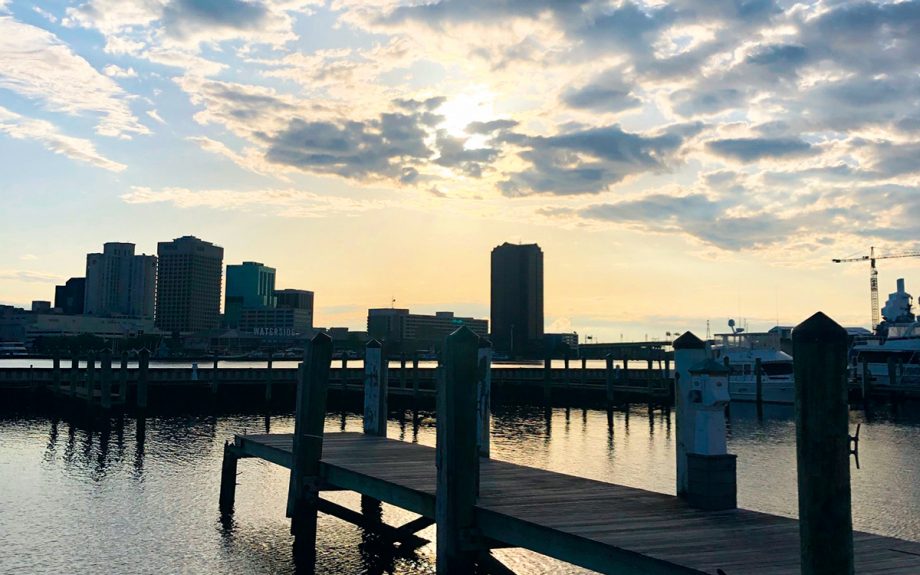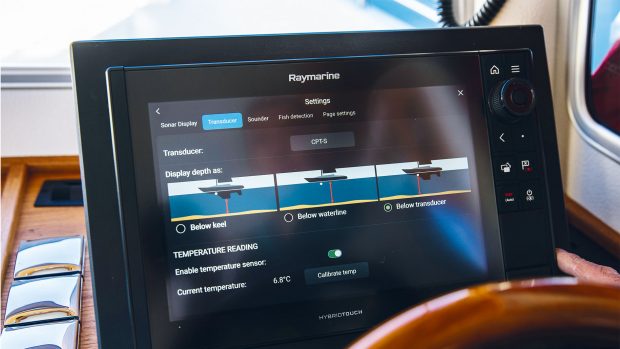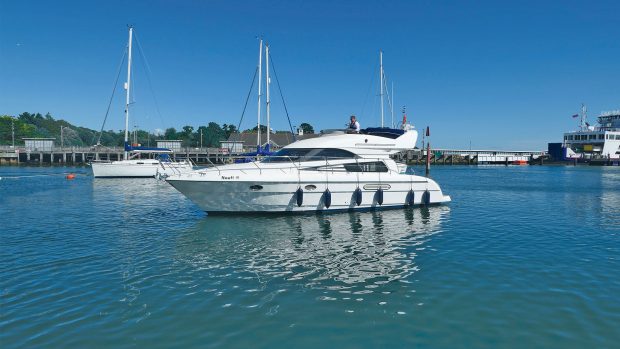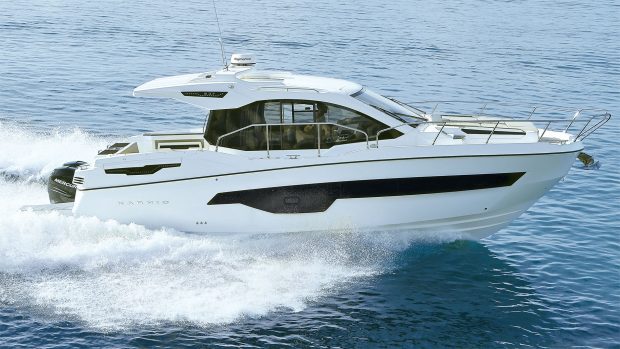Having decided to fulfil a lifelong dream of cruising the Great Loop from Florida to the Great Lakes, expat Princess V48 owner Elliott Maurice sets off on the first leg of his epic adventure.
This is Part 2 of our Cruising the Great Loop series, make sure to read Part 1 first.
Carefully planning a trip that spans over 2,000nm, especially one in which the end destination is not the same as the one you started from, requires meticulous groundwork. Above all you need to make sure the boat is ready for the sheer rigours it will endure, along with an inventory of spares and tools to cover the most likely failures.
With this in mind I arranged for my Princess V48’s engines and generator to have a full 1,000-hour service, including checking the injectors, flushing the heat exchangers, polishing the fuel and cleaning the tanks. In addition to this I decided to completely replace Privilege’s 14-year-old Freon-based Cruisair air-conditioning system with three modern self-contained Webasto units.
Having ordered them back in January 2021, they finally arrived from a Covid-locked-down Germany just three working days prior to our departure date. Even with an army of engineers on board there was no way the boat would be ready to leave on time, forcing us to delay our departure by a day.
Article continues below…

Owner’s upgrade: How I turned my Princess V48 convertible into a coupe cabriolet

Great Loop: Meet the Princess V48 owner preparing for the adventure of a lifetime
Having also updated the software on the new glass bridge Raymarine Axiom MFD and Quantum Doppler radar, I discovered it had turned our autopilot compass into a useless scrambled mess. The quickest solution was to swap the unit for a new one and deal with the scrambled one later. Fortunately, I had allowed a three-day stopover in Port Canaveral in case of any mechanical failure, so the loss of a day was not an issue.
We departed for the first 187-mile leg after an early fuel up of 260 US gallons (984 litres) of diesel to top up to the tanks’ full capacity of 500 gallons (1,893 litres). The early morning start allowed us a clean, easy run across the Haulover sandbar and out through the notorious Bakers Haulover inlet into a rolling 2ft sea.
However, as soon as I engaged the new autopilot it sent the boat into a sudden spin; it seemed to think port was starboard and vice versa. As steering by hand for the next 180 miles wouldn’t be too much of an issue and on arrival we could probably find a dockside wizard to resolve the problem, we pressed on.

Our course took us 5 miles east of the shoreline straight up the South Florida coast. The boat ran beautifully, averaging 25 knots and chomping away at the distance with ease. The new air-conditioning provided a cool haven from the blistering 32° heat. Even the sea temperature was showing just over 30° in Miami, so monitoring engine temperatures was a critical part of every watch.
As we passed West Palm Beach the wind direction swung through 180° and immediately kicked up a 4ft sea with a stiff 15-knot breeze whipping over the bow. Thankfully, Princess’s long-time hull designer Bernard Olesinski knows how to create a soft-riding hull, which the yard builds to perfection. Despite the onslaught, there wasn’t a creak or squeak to be heard from my 14-year-old boat. Parting water like a knife through butter we continued surging our way up the Florida coastline.
We arrived at Port Canaveral, home of NASA’s Kennedy Space Center, at around 1700, only to find that our allocated berth was only 16ft wide and guarded on either side by barnacle-encrusted pilings which the falling tide had exposed. This left us just 6in of clearance to avoid scratching Privilege’s flawless paintwork. A 15mph crosswind only added to the peril, requiring delicate nudges to the thrusters to squeeze through into our berth.

Port Canaveral Yacht Club
With the first day’s challenges safely surmounted, we headed off to sample the local cuisine and nightlife. We soon found a waterside restaurant with a huge tiki bar and live band serving fresh fish and juicy burgers accompanied by good music and a lively atmosphere. With the beers and cocktails flowing, it provided the perfect end to a great first day.
The next morning our attention turned to the confused autopilot. As predicted a local dockside wizard quickly brought the system back to life by resetting the wheel then executing a full port and starboard turn. Meanwhile, we set out to visit the Kennedy Space Center.
Just like the maritime explorers of yesteryear, NASA embodies the same pioneering spirit of our age so we were all intrigued to learn more about these brave and inspiring men. The tour took us from NASA’s early attempts to break the sound barrier through the Apollo missions to the space shuttle and proved to be a fascinating experience.

Boaters flock to Cape Canaveral to watch NASA rocket launches. Photo: Danita Delimont / Alamy Stock Photo
Port Canaveral is also a Mecca for boaters wishing to view rocket launches from some of the best viewpoints around. NASA publishes launch dates well in advance and marinas are soon packed with boat owners vying for the best seats in the house. Our second evening was spent at a local dockside restaurant aptly named Fishy Lips, where we all shared a freshly caught grouper, chargrilled and served with homemade coleslaw.
The next leg of the journey north to Jacksonville required another top up of 260 or so gallons (985 litres), giving us an average fuel consumption of 0.7mpg at 25 to 28 knots as predicted by the Volvo Penta engine management. With 166nm ahead of us and comfortable passage-making conditions, we were confident of covering the miles in around 5 hours.
We left the dock at 0900 with the temperature already in the low 30s and a refreshing breeze to cool us down as we ventured out into the salty stuff – perfection.

Elliott’s Princess V48 Privilege
Space race
For the first 30 miles we enjoyed an amazing vista of NASA’s many launch sites dotted along the shoreline, including Elon Musk’s new Space X facilities. The route required a dog leg turn 6 miles out of Port Canaveral to navigate around the South East Shoal before turning true north almost the entire way.
The autopilot worked a treat for about 30 minutes before it lost its bearings, so once again we were forced to disengage it and continue on manual. Around 50 miles in, I noticed the temperature of the starboard engine start to climb. Although it didn’t reach overheat level, it was a definite 6° or so hotter than the port engine.
After a quick visual inspection of the engines, I noticed a black film had coated the inside of the engine hatch and bulkheads. With the strong following wind in mind, I couldn’t be sure whether this was caused by an exhaust leak or blowback through the intakes.

Tracking down the source of an overheating starboard engine
As it was still well off critical overheat levels, we continued running at a brisk 25 knots. However, 20 miles further on, the temperature continued to climb and the shrieking alarm immediately forced us to shut down the starboard motor and limp along on one engine while we tried to figure out the problem.
Unfortunately, the searing Florida heat and high operating temperature of the big turbo diesels made anything more than a couple of minutes snooping around the engines unbearable. Privilege can only comfortably cruise at around 6 knots on one engine so our 5-hour journey was about to become significantly longer. We still had 90 miles to go to our planned destination and with no other safe harbours en route our options were not entirely favourable.
With this in mind, and the starboard engine now sufficiently cooled, we made the decision to run the poorly engine at low revs so we could at least trawl the rest of the way at a lethargic 13 knots rather than a stultifying 6 knots. This resulted in a rather arduous 7 hours of winding in our course at displacement speed while at the mercy of the swells and without the benefit of autopilot.

Makena holds a steady course to Jacksonville
A phone call to a friend at Fairline (US) found us an excellent marine engineer who could meet us at Charleston and help us get back to fighting speed in a day’s time. With spirits lifted, we arrived in Jacksonville an hour before sunset.
Jacksonville is known for three things; great seafood, gorgeous beaches and shark infested waters! The former two options being our preferred options, after a quick wash down of both the boat and ourselves, we set out with a reservation for the highly recommended North Beach Fish Camp.
A short taxi ride took us to the pretty little town centre and our intended venue but while the guys were being shown to their table, I sneaked off for a quick walk to the beach. A narrow cut through the sand dunes opened out to one of the most gorgeous natural beaches I have ever seen.

Cutting through the sand dunes to Jacksonville’s magical beach
Crowned by a magnificent sunset, the sweeping arc of white sand was truly a sight to behold. Unspoiled by high-rise hotels, this beach is spectacular. Our meal turned out to be excellent and my so-called “English Fish and Chips” was as good as anything served back in Blighty.
The next morning, cool engines and a refreshing breeze allowed me a thorough inspection of the soot-covered engines. I soon spotted that the heat shield had come away from the starboard exhaust and a small leak had developed around the seal. Although a simple fix, it was a serious issue that needed proper attention. A quick run to the hardware store to pick up some heatwrap and exhaust clamps allowed us to effect a temporary repair, which I hoped would get us the 220 miles to Charleston at low speed.
Within a couple of hours, cleaning up as best I could and topping up the coolant as necessary, we were ready to proceed. A safety briefing and discussion with the crew resulted in a re-route that would involve a shorter offshore passage than originally planned.

Watching the sun set over Privilege’s bow in Jacksonville Marina
We decided to exit the St Johns River as planned into the North Atlantic but only for 11nm before ducking back into the St Mary’s River just north of Amelia Island on the Georgia border. The remaining 150nm would follow the winding intracoastal waterway to just south of Savannah at a gentle 18-knot cruise.
With this in mind we headed out as planned in a northerly direction. The first few miles passed easily with the starboard engine holding a steady temperature, although the helm seemed to creep away from its designated course and required constant small corrections.
We put it down to the strong currents in the gulf stream and carried on unconcerned. Once safely back on the intracoastal, we headed for our planned lunch stop at the exclusive Fernandia Harbour marina on the Amelia River. The marina is full of fabulous Viking sportyachts and provided an excellent lunch with great facilities. It also gave us the opportunity to inspect the starboard engine and exhaust manifold for any signs of deterioration.

Privilege dwarfed by the high-rise sportsfishers in Fernandia Harbour
Veering into danger
While we were eating we received a text message from our shore-based coordinator, telling us that there was a Trident nuclear submarine base only a few miles deviation from our intended route. We weren’t going to let that opportunity go begging so with our updated Navionics route loaded on a tablet, we set off to see some of the US Navy’s most secret assets.
Heading up a wide, deep river hidden away from the busy intracoastal, we came across a large structure to port, which we later discovered to be a degaussing station that demagnetises the submarines and makes them harder to track. Soon after, the ominous grey hull of a fast attack submarine emerged from the banks. In the distance vast hangars loomed over the still waters and a patrol boat kept a watchful eye on us and the submarine.
The river ahead and the entrance to the naval base was clearly visible but our plotter was showing a less obvious 90° starboard turn back into the intracoastal. Without realising, my co-captain at the helm continued straight on rather than bearing away toward the domestic channel.

The degaussing station used to demagnetise US Navy submarines
Instantly, another Navy patrol boat swung out from nowhere, hailing “bear away NOW” while swinging its deck-mounted 50-calibre machine gun directly towards us. Unaware of the impending carnage, Alan continued toward the base. “Bear away,” I repeated to Alan rather more vociferously, while grabbing the VHF from its mounting.
Crisis averted
“Navy, Navy, this is Privilege, Privilege, looking for directions to the ICW channel,” I hailed, panic-stricken. By this stage, Alan had started his turn to starboard and the patrol boat immediately slowed and turned its machine gun safely away. Polite instructions followed and we were soon headed safely back towards the domestic waterway. Lesson duly learnt that the US Navy is understandably defensive of its nuclear submarines!
A gentle river cruise followed for the next 20 miles and as the engines settled, we took a shortcut back into the ocean to make up some time. We received another message from our shore-based captain, Jill, telling us to “get more fuel”. A main oil pipeline had been taken hostage by cyber-terrorists and a fuel shortage was predicted. We re-routed again into the next inlet to St Simons Marina, east of Brunswick in Georgia.

Approaching a swing bridge on the intracoastal waterway
Safely topped up, we continued north on the intracoastal. With time lost refuelling and the complex river-to-river navigation, we decided to cut short our planned leg and head for a closer marina we could reach by night fall. This would take us through a stretch of water ominously called Hell Gate. We continued into the desolate salt marshes of Georgia, enjoying some of the best boating I’ve ever experienced.
Running a big sportscruiser through 50 miles of winding marshland at 18 knots, without another soul in sight, was intoxicating. One fast sweeping turn led to another as we hopped from marker to marker and river to river, accompanied by dolphins surfing in our wake and eagles circling overhead.
We all took turns as spotter and helmsman as the miles streaked by into the sunset. Just as last light began to fall we entered the section known as Hell Gate. Narrow and poorly marked, we had pilotage instructions from the marina to follow the channel markers not the GPS chart. After several minutes with me on the bow calling markers, James, an experienced yachtsman, called out, “The plotter says we’re on land.” “Stop the boat,” I yelled. “Are we in water?” “22ft,” he responded.
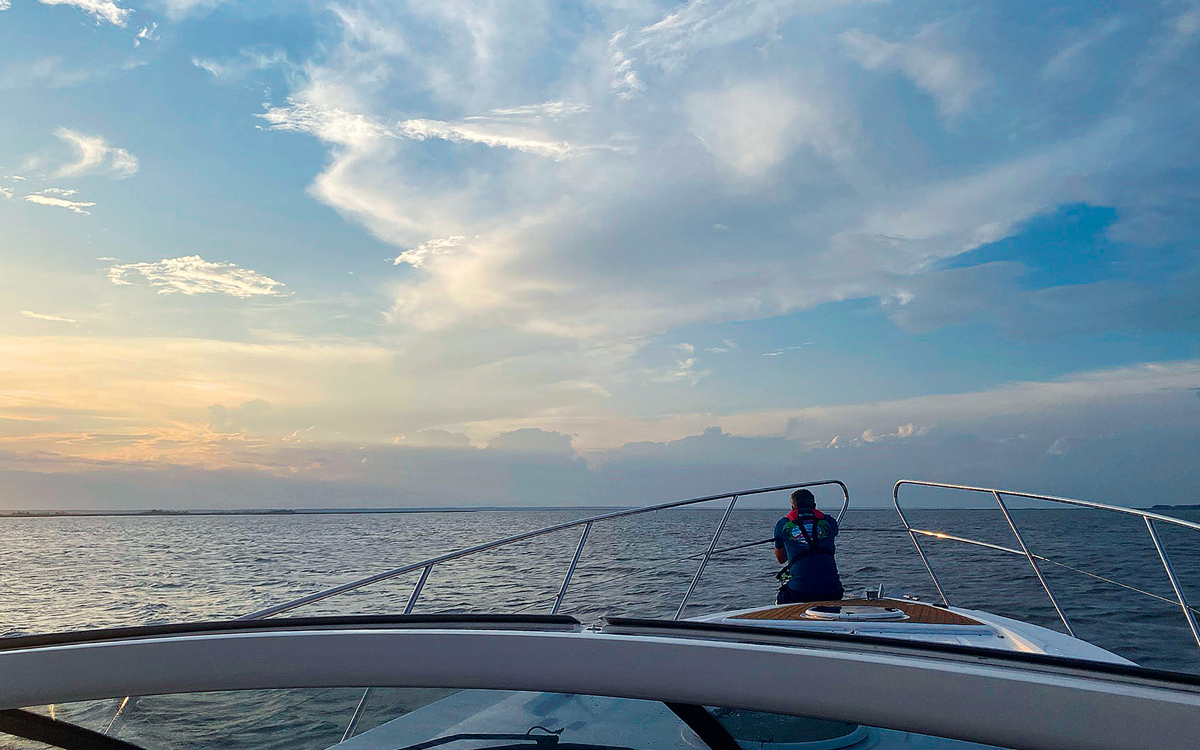
Cruising through the marshes to Hell Gate
I took the helm and sure enough the well marked channel we were following had taken us onto what was shown as land on the chart. After a quick deliberation and re-read of the pilotage instructions, we decided the shifting marshes required constant relocation of the channel markers but the lack of marine traffic did not produce adequate sonar information to keep charts updated.
Under cloud cover and in almost complete darkness with a rapidly increasing wind, we crept into Delegal Creek Marina for the night, breathing a collective sigh of relief.
The first two legs of our trip had been challenging but exhilarating. This is exactly the kind of adventure I’d been hoping for and we were only a few days in. To be continued…
First published in the September 2021 issue of MBY. In Part Three, Elliott heads for Norfolk, Virginia.
If you enjoyed this…
Be first to all the latest boats, gadgets, cruising ideas, buying advice and readers’ adventures with a subscription to Motor Boat & Yachting. Available in both print and digital formats, our monthly magazine will be sent directly to your home or device at a substantial discount to the usual cover price. See our latest offers and save at least 30% off the cover price.

The entrance to Charleston Harbour
